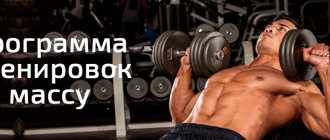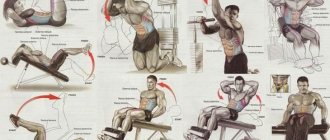Training programsMiscellaneous
German Volume Training (GVT), or the principle of 10 sets of 10 repetitions, is said to have been made popular by Rolf Feser, coach of the German national weightlifting team. The training program was used during the off-season and had two main goals:
- Helped weightlifters gain muscle mass.
- Helped athletes burn excess fat.
Rumor has it that German Volume Training has proven to be such an effective muscle-building program that German bulkers often progress to the next weight class in as little as 12 weeks.
In 1996, Muscle Media 2000 magazine published an article on German Volume Training written by Canadian strength specialist Charles Poliquin.
Jacques Demers, a member of the Canadian weightlifting team, believes that it was thanks to German Volume Training that he was able to build truly fantastic leg muscles. Female bodybuilding star Bev Francis also claims that at the beginning of her career she actively used German Volume Training.
What is hidden behind the abbreviation "NOT"
I confess, having been born and having lived almost my entire adult life in Germany, I learned about German volumetric training (VOT) not too long ago - about seven years ago, after reading one of the works of the American strength training specialist Charles Poliquin. It is unknown what brought the “silovik” trainer to the “mass-gaining spaces”, but it was Poliquin who revived to life the training methodology that had already been written off in the archives. Of course, having considerably modified it. But we will talk about NOT modifications a little lower, but for now we will consider this system in its classical, so to speak, version.
German volume training is a medium-intensity training (although many people mistakenly call it high-intensity training) aimed at muscle hypertrophy. HOT is usually built into the training process by micro- or mesocycles, replacing periods of strength or high-intensity training. Practice shows that such a change in intensity and volume leads to a sharp stimulation of the muscle growth process - cases of gaining 4-5 kg of muscle mass in 3 weeks of German volume training are not uncommon. The usual duration of training according to the NOT system is 2-3 weeks, but no more than four or five - after this period of time, German volumetric training loses all meaning.
The essence of NOT is extremely simple - do 100 repetitions per muscle group throughout the workout. In the “classic” version, this is 10 sets of one exercise, 10 repetitions each, with the same weight. In order to cope with such a volume of work, the weight of the burden should not exceed 60% of the one-time maximum, or even less. If you completed all 100 repetitions with this weight, you should increase the weight of the weight in the next workout.
Let me emphasize again: since HOT uses the ability of the muscles to achieve voluntary failure in response to a high volume of training, a very important component is the weight of the weight - not too large so that the planned volume of training can be completed, but not too small so that voluntary failure will not occur. finally came.
The words “muscle group” usually mean quadriceps, hamstrings, chest, back, triceps, biceps and deltoids. Trapezius, abs, calf muscles and forearms, as a rule, are not trained according to this scheme, allocating them 3-4 sets at the end of the workout. As for the exercises, compound exercises are usually used - bench presses, pull-ups, barbell rows, dips, biceps curls, etc. Since the training is voluminous, but its intensity is not so high, one muscle group can be worked out once every five days. A typical split for NOT looks like this:
- Day 1: chest back
- Day 2: legs, abs
- Day 3: rest
- Day 4: Arms, delts, forearms or traps
- Day 5: rest
- Day 6: Start of a new cycle
Lately there have been too many options for NOTES. This includes “optimized volume training”, and “the most effective”, and “the best”. It’s easy to get confused in such advertising terminology, so in the future I will simply number the versions of NOTES indicating the author. But in general, any of you, dear readers, with due perseverance, the necessary minimum of knowledge and common sense, is able to “build” your own version of NOTES. And also call it something.
Warning
German volume training is only suitable for athletes with at least a year of serious training experience - at least 150 hours of training and a gain of at least 10 kilograms of pure muscle mass.
The athlete must have experience performing at least five sets of one exercise and experience performing sets of 10-20 repetitions.
If you are used to doing 3 sets per exercise or have always preferred to work on strength up to 5 repetitions per set, then German volume training will be a real shock for your body and especially for your heart.
I never tire of reminding my clients of the word “working in.” It is better to first slowly accustom your body to doing 10 approaches per exercise without taking into account time, and only then test your body in German volume training.
Have you ever tried doing 5 sets of 10 reps with a minute of rest? Do you know how to do exercises 20 times? For example, can you do 20 pull-ups?
If you can do 20 pull-ups, you can try German volume training.
Can you do more than 20 pull-ups? How long have you been training? Write a comment.
Create a training plan for a week for free
Option #1 (Charles Poliquin)
The considerable merit of Charles Poliquin is that he brought German volumetric training back to life. At the same time, the scheme proposed by this specialist, in my opinion, is quite far from perfect, especially since it abandoned the basic principle of NOT - 100 repetitions per muscle group per workout. To the main exercises, combined into a modified superset and performed according to the 10x10 scheme, Poliquin added a modified superset of auxiliary exercises, performed according to the 3x10-12 scheme.
In general, Charles Poliquin's program looks like this (using the example of training the chest and back, A - the first superset, B - the second superset):
| Exercise | Sets | Repetitions | Pace | Rest, with |
| A1 - dumbbell press on a reverse incline bench | 10 | 10 | 4020 | 90 |
| A2 - reverse grip pull-ups | 10 | 10 | 4020 | 90 |
| B1 - dumbbell flyes on an incline bench | 3 | 10-12 | 3020 | 60 |
| B2 - bent over dumbbell row | 3 | 10-12 | 3020 | 60 |
Weight weight - 60% of the one-time maximum, both in the first and second superset.
Poliquin recommends replacing six cycles (30 days) of such training with three weeks of much lower volume training (but also of medium intensity), after which he suggests moving on to the next version of NOT (again, chest and back training is considered):
| Exercise | Sets | Repetitions | Pace | Rest, with |
| A1 - Incline Dumbbell Press | 10 | 6 | 5010 | 90 |
| A2 - wide grip pull-ups | 10 | 6 | 5010 | 90 |
| B1 - dumbbell flyes on a flat bench | 3 | 6 | 3010 | 60 |
| B2 - bent over row with EZ bar | 3 | 6 | 3010 | 60 |
Here the intensity increases by reducing the tempo in the concentric phase of the movement and slightly increasing the weight of the weight. Unfortunately, practically nothing remains of the fundamental principle of NOT in this approach.
It’s interesting that for training the shoulders, Poliquin singles out just one exercise at the very end of the arm workout - the specialist believes that indirect load on the shoulders is quite enough.
Option No. 2 (TC Luoma)
The editor-in-chief of the virtually unknown Testosterone Magazine in Russia also decided to contribute to the improvement of German volumetric training. It turned out pretty well for him. Luoma is a proponent of the theory that each muscle should be worked from different angles in each workout. In addition, this modification of NOT makes this type of training not so boring. Here are examples of constructing a training session for various muscle groups:
Breast
- Incline bench press 3x10
- Reverse Incline Bench Press 3x10
- Flat bench press 3x10
- Dumbbell flyes on a flat bench 1x10
Back
- Wide grip overhead rows 3x10
- Medium grip rows to chest 3x10
- Reverse grip rows 3x10
- Bent-over barbell rows 1x10
Quadriceps
- Front squat 3x10
- Squat (barbell on the back), legs narrower than shoulder width 3x10
- Squat (barbell on back), feet shoulder-width apart 3x10
- Leg extensions 1x10
Biceps hamstrings
- Bent-over with a barbell on the back 3x10
- Romanian deadlift standing on a 3x10 stand
- Romanian floor deadlift 3x10
- Leg curls 1x10
Shoulders
- Chest presses with medium grip 3x10
- Overhead presses with medium grip 3x10
- Very wide grip chest presses 3x10
- Dumbbell lateral raises, standing 1x10
Triceps
- French bench press (to the forehead) 3x10
- French bench press (to the chin) 3x10
- French press behind the head 3x10
- Reverse Grip Press Down 1x10
Biceps
- Curls with dumbbells on a Scott bench 3x10
- Bench curls with dumbbells while sitting on an incline bench 3x10
- Standing dumbbell curl 3x10
- Reverse grip barbell curl 1x10
These exercises are not a dogma; you can choose your own complex. The same weight is used in the first three exercises for the muscle group. Rest between sets is 60-90 seconds, exercise tempo is 4020 for large muscle groups, 3020 for small ones. A six-day (in this case) split might look like this:
- Day 1: Quadriceps
- Day 2: chest, triceps
- Day 3: rest
- Day 4: hamstrings, shoulders
- Day 5: back, biceps
- Day 6: rest
- Day 7: Start of a new cycle
Method "10x3"
The author of the method belongs to physiologist Chad Waterbury. According to the author, when using the method, the maximum number of fast-twitch fibers (types IIa and IIb) is involved in the work. As for slow-twitch fibers (type I), Waterbury neglects them, considering their growth potential to be very insignificant. Well, for people with a predominance of fast-twitch fibers, this is true.
The essence of the method is clear from its name: ten sets of exercises (preferably basic) are performed with three repetitions in each set. The weight of the weight is selected so that you can do 5-6 repetitions. Rest between sets – 1-2 minutes (it is advisable to focus on the first number). The tempo of the exercise is 20X (lower in two counts, do not hold the weight in the lower position, lift as quickly as possible).
The method will work well if your one-rep max is high enough (at least 150-160 kg in the bench press, about 200 kg in the squats). Otherwise, the applied effort may not be enough to stimulate the muscles well. The method is not intended for training small muscle groups.
Option #3 (Christian Thibodeau)
The version of this famous strength training specialist is perhaps one of the most interesting. Unlike the previous two specialists, Thibodeau uses a seven-day split, which looks like this:
- Day 1: chest, back
- Day 2: legs, abs
- Day 3: rest
- Day 4: biceps, triceps
- Day 5: rest
- Day 6: Shoulders
- Day 7: rest
- Day 8: Start of a new cycle
Thibodeau was the first to divide the exercises in the daily complex into heavy and light - he combined them into a combined set. In addition, he does 2 different combination sets per muscle group throughout the workout. I will give his version of NOT using the example of biceps and triceps training (A, B, C and D are different combined sets):
| Exercise | Sets | Repetitions | Pace | Rest, with |
| A1 - barbell curls | 5 | 5 | 2010 | No |
| A2 - dumbbell curls | 5 | 5 | 6020 | 120 |
| B1 - Scott Bench Curls | 5 | 5 | 2010 | No |
| B2 - Hummer | 5 | 5 | 6020 | 120 |
| C1 – Dips for triceps | 5 | 5 | 2010 | No |
| C2 - French Reverse Press | 5 | 5 | 6020 | 120 |
| D1 - standing French press | 5 | 5 | 2010 | No |
| D2 - press down on the block | 5 | 5 | 6020 | 120 |
In the first exercise of the combined set, a slightly larger weight is used than usual - at the level of 70-75% of the one-time maximum. A necessary condition is that the weight of the weight in the first exercise of the combined set increases from week to week. The second exercise of the combination set is a pump exercise, performed in a strict style and at a much slower pace. The weight of the weight in this exercise is not so important - the main thing is that you manage to master all the sets without much stress.
And since the central topic of this issue of the magazine is training the shoulders, it would be useful to present Thibodeau’s program for training the deltoids (all the comments made about training the biceps and triceps are also valid in this case):
| Exercise | Sets | Repetitions | Pace | Rest, with |
| A1 - standing chest press | 5 | 5 | 2010 | No |
| A2 - seated lateral raises with dumbbells | 5 | 5 | 6020 | 120 |
| B1 – seated dumbbell press | 5 | 5 | 2010 | No |
| B2 - pull of the lower block to the chin | 5 | 5 | 6020 | 120 |
| C1 - seated lower block row to the upper chest | 5 | 5 | 2010 | No |
| C2 – bent over dumbbell raises | 5 | 5 | 6020 | 120 |
Option #4 (Timo Neumann)
Your humble servant uses his own version of NOT in the training process. It is somewhat similar to the option proposed by Christian Thibodeau, but it also has significant differences. Firstly, I do not combine exercises into a combination set, and secondly, I only do one heavy exercise per muscle group. As for light (pumping) exercises, usually performed in simulators, there can be either one or two. Below is my version of NOTE using the example of training the chest and back muscles
| Exercise | Sets | Repetitions | Pace | Rest, with |
| Incline Barbell Press | 6 | 6 | 2010 | 90 |
| Crossovers lying on a reverse incline bench | 4 | 8 | 4020 | 30 |
| Hand raises in the butterfly simulator | 4 | 8 | 4020 | 30 |
| Parallel grip chest pull-ups | 6 | 6 | 2010 | 90 |
| Bent-over dumbbell row | 4 | 8 | 4020 | 30 |
| Lower pulley to the waist | 4 | 8 | 4020 | 30 |
In order to properly work all muscle groups, exercises can be changed from workout to workout. In “heavy” exercises, you can use a significant weight of weights - at the level of 75-80% of the one-time maximum. It is advisable to increase this weight from workout to workout. Weight in “light” exercises does not matter much - the main thing in this case is to maintain minimal intervals between sets.
Another option is to put a warm-up (muscle-stretching) exercise at the beginning of the program, and reduce the number of “pumping” sets by increasing the number of repetitions in them. For biceps, for example, it would look like this:
| Exercise | Sets | Repetitions | Pace | Rest, with |
| Alternating lifting of dumbbells on a bench with a backrest angle of 30 degrees | 2 | 8 | 4020 | 60 |
| Standing biceps curl | 6 | 6 | 2010 | 90 |
| Concentrated curls on the lower block | 3 | 16 | 4020 | 30 |
If we talk about muscle groups, the deltoids are the only one (besides the forearms and calves) that I do not load using the volumetric training method. My usual split for NOT is five days, but if I need to “tighten up” a lagging muscle group, I switch to an eight-day split, training the muscles lagging behind in development twice during the cycle.
That’s probably all I wanted to tell you today about German volumetric training. Try it - maybe this is exactly what you were missing. If something remains unclear, ask, I’m always happy to help you.
Training theory
Since time immemorial, there has been debate about what is better: lifting heavy weights for a small number of repetitions, or lifting moderate weights, but doing more work through additional exercises and approaches. Alas, there is still no clear answer to this question. Each person is individual; volume training may be suitable for one, and high-intensity training for another. Or it may happen that at a certain stage in the training process, a sharp change in methods will bear fruit. Let’s try to understand more specifically what high-intensity and volume training are.
A few words to end the topic
I have read and heard more than once from many experts that medium-intensity volume training in general and German volume training in particular do not promote muscle growth, that is, hypertrophy of muscle fibers. As for hypertrophy, here we can agree with the opinion of the majority - NOT, most likely, does not lead to an increase in the cross-section of muscle fibers in response to an extreme load [1], but muscle growth is not only that.
In addition to hypertrophy, muscle can grow due to:
- increasing the number of capillaries in it;
- increasing its ability to store energy components (and not only), both inside and outside the cell. These components include: glycogen, creatine, fat, water;
- finally, muscle growth is also observed due to hyperplasia of muscle fibers, that is, an increase in their number.
conclusions
Finally we have come to logical conclusions. So, is volume training better than high-intensity training? Yes, but not one hundred percent. In both cases there are pros and cons, but in Weider’s system there are fewer of them. Yes, the volume of loads in this system is greatly overestimated, but nothing prevents us from reducing it and adjusting it to our recovery abilities. No one forbids switching to high-intensity HIT-style training from time to time, and then returning to volume training.
At different stages of the training process, any of the listed methods will bear fruit. In essence, Joe Weider's volume training and Jones-Mentzer's HIT are two extremes of bodybuilding, and the truth lies somewhere in the middle. Draw your own conclusions.










